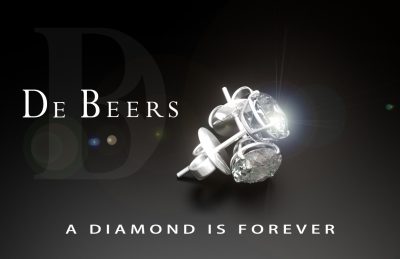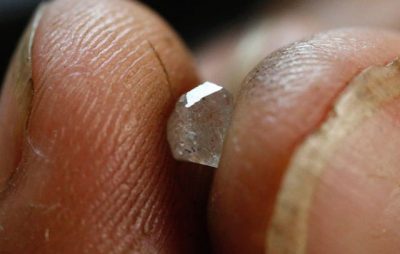First, a quick overview of the diamond market. Diamonds are a multi billion dollar business (Diamond Jewelry business valued at $74.2 Billion). Diamonds are durable goods, meaning they last for several time periods. Operating under a value chain framework (company value adding through multiple mediums), the diamond business is segmented into Miners and Producers, Cutters and polishers, Jewelry Manufacturers, and retailers. About 133 million carats of rough diamonds are produced each year, and in fact four control about 65 percent of the market (De Beers controls about 35% of the market). Diamond Giant De Beers in a 2004 interview with Fox Business warned that diamond prices could rise in the coming years as the gemstones become rarer. No matter how big the mine is, one still has to move rocks to get a very small number of diamonds.
But, are diamonds really that rare? Companies such as De Beers face criticism for the belief that large scale mining projects across the world invest billions of dollars every year to produce and control the supply chain, and in the end knowing the demand for diamonds will not be reduced by the end consumer. Their is criticism that De Beers has created a monopoly trading industry, where the supply is controlled. Coase’s conjecture states that “a durable goods monopoly that sells its product has less market power… when compared to a monopoly that rents the durable good”. The paradox is, when selling a durable good, more market power leads to less market power. Basically, the theory that there is no difference in outcome between renting and selling if consumers are convinced that the monopoly will continue with its pricing policy in the future does not hold based on De Beer’s current market moves. The company is now trying to solve the problem of consumer expectations. For a durable goods monopoly; you are trying to rent instead of sell, convince consumers that future production will be limited, produce less durable goods as a monopoly, and get a reputation for never lowering prices De Beers cartel relies on controlling quantity to artificially increase price as part of their anticompetitive tactics. If prices fall, De Beers reduces supply. If new suppliers emerge, De Beers will flood market and sell below market prices. Essentially, these tactics have allowed De Beers to have arguably the largest and longest lasting monopoly of all time. Yet, their realization of current consumer trends and furthering incentives to lower prices has forced them to shift their focus to marketing and brand name. It be kind of disheartening to spend thousands of dollars on a ‘rare” diamond jewelry and then realizing that the price is artificially controlled.
Sources Consulted
Click to access DeBeers2008.pdf
http://www.wakingtimes.com/2016/02/13/when-ignorance-isnt-bliss-the-truth-about-the-diamond-industry/
http://www.cnbc.com/2016/06/16/blame-millennials-diamond-jewelry-business-in-a-rough-spot.html


13 Comments
During your research for this blog post, did you come across any other industries that center around “rare” goods that are in fact not rare, but controlled supply-wise by a small group of suppliers? When reading your post, I thought about cartels such as OPEC, that take a resource and restrict its supply in order to artificially manipulate price. The question that I have in regard to the diamond industry is, why do consumers continue to buy into diamonds being a “rare resource” if they obviously are not?
Sam, I definitely did, and I think oil is a fine example of this. I think the cultural appeal of a diamond is still very strong, and remains a status symbol. Also, I do not think most people who understand the economics behind many of these businesses, and thus are born with the perception that an item is valuable. I read somewhere that diamond would be much cheaper if it was just used for industrial reasons.
I am puzzled that you mention renting is a common trend in the diamond industry. Who rents a diamond?…normally you buy diamond jewelry for an extremely special occasion (wedding proposal, anniversary, etc). The gift has an enormous amount of sentimental value that the recipient will cherish for a lifetime, hence why it is purchased and not rented.
Having done a bit of googling, it appears that there is a genuine market for people to rent diamond jewelry. It makes sense, people might want to look especially good for one-off occasions, and thus decide to rent fancy jewelry for the night, knowing that they don’t have to commit to owning that expensive piece of jewelry.
I find diamonds and other rare gems (as well as precious metals) so interesting in that their value is completely artificially determined. There is no value to these things outside of the value we assigned them for being shiny. Similar to what Sam said when cartel’s manipulating price was stated my mind went to OPEC, but oil at least serves a purpose. It powers our cars, businesses, etc. Gems and metals are merely a status symbol, nothing more, so the fact that a business can inflate prices on it’s consumers for such an object is puzzling to me.
The value of a lot of things are artificially determined as well, including our currency. Professor Davies refers to this perception as a mass disillusionment.
When I think about the diamond industry, I think it shows many similarities to the greeting card industry which was created to exploit consumers and based its business solely on heavy marketing until its product became a recognized societal norm. Americans only occasionally exchanged engagement rings prior to a successful marketing campaign by De Beers in 1930s, and now it is an expected practice. I am curious what will be the highest price threshold for diamonds that De Beers could set before the consumers recognize that they are being exploited and stop buying the product.
Even the market demand for diamonds was artificially created, arising from the engagement process that De Beers’s marketing campaign popularized. In 1938, De Beers hired the advertising agency, N.W. Ayer&Son, to help them expand the U.S. market for engagement rings. The marketing ploy to promote the diamond as a symbol of family success and high socio-economic status certainly worked, as today, 80% of women in the U.S. receive diamond rings when they get engaged. Furthermore, to maintain their high prices, De Beers continuously seeks to monopolize the diamond supply chain by buying out most of the world’s diamond mines. When new mines are discovered and refuse to join their syndicate, De Beers retaliates by unloading massive amounts of diamond to drive down price, forcing their challengers out of the market until once again it is able to control supply and price. This coupled with the status that the diamond is now attributed with due to generations of successful marketing, has allowed the commodity to masquerade as an investment, even so in actuality it is a depreciating asset, whose price is artificially inflated, and which unlike gold and silver, cannot store value, appreciate, or be used to hedge against inflation.
Yeah I think the advertising scheme noted above plays into what we have learned in class about the power of advertising. Interesting comment.
Since diamonds and the jewelry they are used to create are long-lasting products, I wonder how much of the market has the potential to be lost to hand-me-downs and other forms of passing ownership. Every city in America probably has at least a couple of pawn shops holding a bounty of old jewelry. Particularly during periods when De Beers decides to sell at higher prices, it would seem logical that people looking to buy jewelry would buy used. Maybe this is an insignificant percentage of the market, but I would be interested to see how large the supply and demand for used jewelry is.
Have there ever been talks between those other three diamond companies regarding a merger? While as we learned, mergers usually fail, but it seems as though one like this would actually allow those companies to be on the same level as DeBeers, effectively ending their monopoly. Now this obviously isn’t likely to solve the problem of artificial pricing, as now there are two giant firms as opposed to just one, but it probably would help with some of the problems that DeBeers creates for the purpose of profit.
Diamond is most precious and durable metal in others. Blue Nile review shows a lot of art that was designed to be used by consumers and its business was designed to be heavily marketed until its products became a recognized social norm.
Diamond is most precious and durable metal in others. blue nile review shows a lot of art that was designed to be used by consumers and its business was designed to be heavily marketed until its products became a recognized social norm.
Comments are closed.